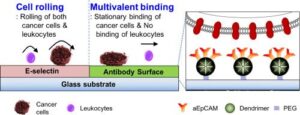Abstract
Circulating tumor cells (CTCs) have received a great deal of scientific and clinical attention as a biomarker for diagnosis and prognosis of many types of cancer. Given their potential significance in clinics, a variety of detection methods, utilizing the recent advances in nanotechnology and microfluidics, have been introduced in an effort of achieving clinically significant detection of CTCs. However, effective detection and isolation of CTCs still remain a tremendous challenge due to their extreme rarity and phenotypic heterogeneity. Among many approaches that are currently under development, this review paper focuses on a unique, promising approach that takes advantages of naturally occurring processes achievable through application of nanotechnology to realize significant improvement in sensitivity and specificity of CTC capture. We provide an overview of successful outcome of this biomimetic CTC capture system in detection of tumor cells from in vitro, in vivo, and clinical pilot studies. We also emphasize the clinical impact of CTCs as biomarkers in cancer diagnosis and predictive prognosis, which provides a cost-effective, minimally invasive method that potentially replaces or supplements existing methods such as imaging technologies and solid tissue biopsy. In addition, their potential prognostic values as treatment guidelines and that ultimately help to realize personalized therapy are discussed.

Cited by
This article is cited by 9 publications-
Poellmann, M. J., Bu, J., Kim, D., Iida, M., Hong, H., Wang, A. Z., Wheeler, D. L., Kimple, R. J., & Hong, S. (2023). Circulating tumor cell abundance in head and neck squamous cell carcinoma decreases with successful chemoradiation and cetuximab treatment. Cancer letters, 562, 216187. https://doi.org/10.1016/j.canlet.2023.216187
-
Poellmann, M. J., Bu, J., Liu, S., Wang, A. Z., Seyedin, S. N., Chandrasekharan, C., Hong, H., Kim, Y., Caster, J. M., & Hong, S. (2023). Nanotechnology and machine learning enable circulating tumor cells as a reliable biomarker for radiotherapy responses of gastrointestinal cancer patients. Biosensors & bioelectronics, 226, 115117. https://doi.org/10.1016/j.bios.2023.115117
-
Bu, J., Nair, A., Kubiatowicz, L. J., Poellmann, M. J., Jeong, W. J., Reyes-Martinez, M., Armstrong, A. J., George, D. J., Wang, A. Z., Zhang, T., & Hong, S. (2020). Surface engineering for efficient capture of circulating tumor cells in renal cell carcinoma: From nanoscale analysis to clinical application. Biosensors & bioelectronics, 162, 112250. https://doi.org/10.1016/j.bios.2020.112250
-
Dong, J., Chen, J. F., Smalley, M., Zhao, M., Ke, Z., Zhu, Y., & Tseng, H. R. (2020). Nanostructured Substrates for Detection and Characterization of Circulating Rare Cells: From Materials Research to Clinical Applications. Advanced materials (Deerfield Beach, Fla.), 32(1), e1903663. https://doi.org/10.1002/adma.201903663
-
Yang, C., Chen, F., Wang, S., & Xiong, B. (2019). Circulating Tumor Cells in Gastrointestinal Cancers: Current Status and Future Perspectives. Frontiers in oncology, 9, 1427. https://doi.org/10.3389/fonc.2019.01427
-
Sun, B., Hagan, C. T., 4th, Caster, J., & Wang, A. Z. (2019). Nanotechnology in Radiation Oncology. Hematology/oncology clinics of North America, 33(6), 1071–1093. https://doi.org/10.1016/j.hoc.2019.08.002
-
Myung, J. H., Cha, A., Tam, K. A., Poellmann, M., Borgeat, A., Sharifi, R., Molokie, R. E., Votta-Velis, G., & Hong, S. (2019). Dendrimer-Based Platform for Effective Capture of Tumor Cells after TGFβ1-Induced Epithelial-Mesenchymal Transition. Analytical chemistry, 91(13), 8374–8382. https://doi.org/10.1021/acs.analchem.9b01181
-
Dong, J., Zhang, R. Y., Sun, N., Smalley, M., Wu, Z., Zhou, A., Chou, S. J., Jan, Y. J., Yang, P., Bao, L., Qi, D., Tang, X., Tseng, P., Hua, Y., Xu, D., Kao, R., Meng, M., Zheng, X., Liu, Y., Vagner, T., … Zhu, Y. (2019). Bio-Inspired NanoVilli Chips for Enhanced Capture of Tumor-Derived Extracellular Vesicles: Toward Non-Invasive Detection of Gene Alterations in Non-Small Cell Lung Cancer. ACS applied materials & interfaces, 11(15), 13973–13983. https://doi.org/10.1021/acsami.9b01406
-
Myung, J. H., Eblan, M. J., Caster, J. M., Park, S. J., Poellmann, M. J., Wang, K., Tam, K. A., Miller, S. M., Shen, C., Chen, R. C., Zhang, T., Tepper, J. E., Chera, B. S., Wang, A. Z., & Hong, S. (2018). Multivalent Binding and Biomimetic Cell Rolling Improves the Sensitivity and Specificity of Circulating Tumor Cell Capture. Clinical cancer research : an official journal of the American Association for Cancer Research, 24(11), 2539–2547. https://doi.org/10.1158/1078-0432.CCR-17-3078